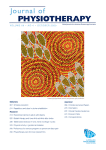Journal of Physiotherapy

Abstract
Question
In adults with stroke, does Bobath therapy improve lower limb activity performance, strength or co-ordination when compared with no intervention or another intervention?
Design
Systematic review of randomised trials with meta-analyses.
Participants
Adults after stroke.
Intervention
Bobath therapy compared with another intervention or no intervention.
Outcome measures
Lower limb activity performance (eg, sit to stand, walking, balance), lower limb strength and lower limb co-ordination. Trial quality was assessed using the PEDro scale.
Results
Twenty-two trials were included in the review and 17 in the meta-analyses. The methodological quality of the trials varied, with PEDro scale scores ranging from 2 to 8 out of 10. No trials compared Bobath therapy to no intervention. Meta-analyses estimated the effect of Bobath therapy on lower limb activities compared with other interventions, including: task-specific training (nine trials), combined interventions (four trials), proprioceptive neuromuscular facilitation (one trial) and strength training (two trials). The pooled data indicated that task-specific training has a moderately greater benefit on lower limb activities than Bobath therapy (SMD 0.48), although the true magnitude of the benefit may be substantially larger or smaller than this estimate (95% CI 0.01 to 0.95). Bobath therapy did not clearly improve lower limb activities more than a combined intervention (SMD −0.06, 95% CI −0.73 to 0.61) or strength training (SMD 0.35, 95% CI −0.37 to 1.08). In one study, Bobath therapy was more effective than proprioceptive neuromuscular facilitation for improving standing balance (SMD −1.40, 95% CI −1.92 to −0.88), but these interventions did not differ on any other outcomes. Bobath therapy did not improve strength or co-ordination more than other interventions.
Conclusions
Bobath therapy was inferior to task-specific training and not superior to other interventions, with the exception of proprioceptive neuromuscular facilitation. Prioritising Bobath therapy over other interventions is not supported by current evidence.
 Blog de Fisioterapia Fisioterapia
Blog de Fisioterapia Fisioterapia



